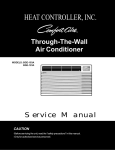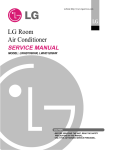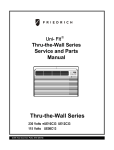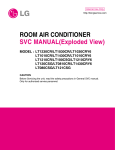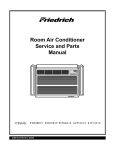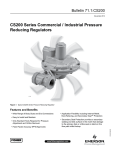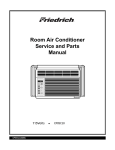Download Friedrich 115 Volts UE08 Air Conditioner User Manual
Transcript
Thru-the-Wall Series Service and Parts Manual Thru-the-Wall Series 115 Volts UE08 230 Volts UE10 UE12 UE08/UE10/UE12 (05/05) CONTENTS 2.4 REFRIGERATION CYCLE..............................9 2.4.1 CONDENSER ........................................9 2.4.2 EVAPORATOR ......................................9 2.4.3 CAPILLARY TUBE.................................9 1. PREFACE 1.1 SAFETY PRECAUTIONS ...............................2 1.2 INSULATION RESISTANCE TEST.................2 1.3 SPECIFICATIONS ..........................................3 1.4 FEATURES .....................................................4 1.5 CONTROL LOCATIONS .................................4 3. TROUBLESHOOTING GUIDE 3.1 OUTSIDE DIMENSIONS...............................12 3.2 PIPING SYSTEM ..........................................12 3.3 TROUBLESHOOTING GUIDE......................13 2. DISASSEMBLY INSTRUCTIONS 2.1 MECHANICAL PARTS....................................5 2.1.1 FRONT GRILLE .....................................5 2.1.2 CABINET................................................5 2.1.3 CONTROL BOX .....................................5 2.2 AIR HANDLING PARTS..................................6 2.2.1 ORIFICE, HEATER ASSY AND TURBO FAN .........6 4. SCHEMATIC DIAGRAM 4.1 CIRCUIT DIAGRAM ......................................18 5. EXPLODED VIEW ..................................19 6. REPLACEMENT PARTS LIST .......20 2.2.2 FAN ........................................................6 2.2.3 SHROUD................................................7 2.3 ELECTRICAL PARTS .....................................7 2.3.1 MOTOR..................................................7 2.3.2 COMPRESSOR .....................................7 2.3.3 CAPACITOR ..........................................7 2.3.4 POWER CORD ......................................8 2.3.5 THERMOSTAT ......................................8 2.3.6 ROTARY SWITCH .................................8 1. PREFACE This SERVICE MANUAL provides various service information, including the mechanical and electrical parts etc. This room air conditioner was manufactured and assembled under a strict quality control system. The refrigerant is charged at the factory. Be sure to read the safety precautions prior to servicing the unit. 1.1 SAFETY PRECAUTIONS 1.2 INSULATION RESISTANCE TEST 1. When servicing the unit, set the ROTARY SWITCH or POWER SWITCH to OFF(O) and unplug the power cord. 2. Observe the original lead dress. If a short circuit is found, replace all parts which have been overheated or damaged by the short circuit. 3. After servicing the unit, make an insulation resistance test to protect the customer from being exposed to shock hazards. 1. Unplug the power cord and connect a jumper between 2 pins (black and white). 2. The grounding conductor (green or green & yellow) is to be open. 3. Measure the resistance value with an ohm meter between the jumpered lead and each exposed metallic part on the equipment at all the positions (except OFF or O) of the ROTARY SWITCH or POWER SWITCH. 4. The value should be over 1MΩ. —2— 1.3 SPECIFICATIONS 1.3.1 FOR UE08A13B/UE10A33B/UE12A33B MODELS ITEMS UE12A33B 9,800/10,000 11,400/11,700 (W) 830 1,040/1,060 1,210/1,250 RUNNING CURRENT (A) 7.5 5.2/4.7 6.2/5.8 E.E.R. 10.0 9.4 9.4 (Btu/h) INPUT (Btu/W.h) (Btu/h) 3,850 9,200/11,200 (W) 1,230 2,900/3,500 RUNNING CURRENT (A) 10.7 14.0/15.3 CAPACITY INPUT INDOOR (°C) OPERATING COOLING OUTDOOR (°C) TEMPERAINDOOR (°C) TURE HEATING OUTDOOR (°C) REFRIGERANT (R-22) CHARGE(g) 380(13.2 OZ) 26.7 (DB) 19.4 (WB) 35 (DB) 23.9 (WB) 21.1 (DB) 15.6 (WB) 8.3 (DB) 6.1 (WB) 440(15.5 OZ) 470(16.6 OZ) 2 ROW 11 STACKS LOUVEREDFIN TYPE 2 ROW 17 STACKS, L-BENDED TYPE 2 ROW 12 STACKS EVAPORATOR CONDENSER TURBO FAN FAN, INDOOR PROPELLER TYPE FAN WITH SLINGER-RING FAN, OUTDOOR 1/ 2/ 2 FAN SPEEDS (FAN/COOLING/HEATING) 6 POLES FAN MOTOR OPERATION CONTROL ROTARY SWITCH ROOM TEMP. CONTROL THERMOSTAT VERTICAL LOUVER (RIGHT & LEFT) AIR DIRECTION CONTROL HORIZONTAL LOUVER (UP & DOWN) TOP-DOWN CONSTRUCTION 1.2KW, 115V ELECTRIC HEATER COMPRESSOR PROTECTOR REMARK 1Ø, 208/ 230V, 60Hz 8,000 CAPACITY HEATING UE10A33B 1Ø, 115V, 60Hz POWER SUPPLY COOLING UE08A13B 3.5KW, 208/230V EXTERNAL OVERLOAD PROTECTOR INTERNAL THERMAL PROTECTOR FAN MOTOR ELECTRIC HEATER FUSE LINK, BIMETAL THERMOSTAT 1.6m (3 WIRE WITH GROUDING) POWER CORD ATTACHMENT PLUG (CORD-CONNECTED TYPE) SPLASHED BY FAN SLINGER DRAIN SYSTEM 73/33 80/36 NET WEIGHT (lbs/kg) DIMENSION (inch) 2421/32 x 1413/32 x 1921/32 (W x H x D) (mm) 626 x 366 x 499 SLEEVE DIMESION (inch) 257/8 x 1517/32 x 1623/32 (W x H x D) (mm) 656 x 394 x 425 SLEEVE DEPTH (inch) 20 WITH FRONT GRILLE (mm) 510 —3— 81/37 OPTIONAL PART 1.4 FEATURES • Designed for cooling only. • Built in adjustable THERMISTOR and THERMOSTAT. • Powerful and quiet cooling. • Top-down chassis for the simple installation and service. • Washable one-touch filter. • Compact size. 1.5 CONTROL LOCATIONS • OPERATION Off Fan Only Low Cool High Cool Low Heat High Heat - Turns the air conditioner off. - The low fan speed operation without cooling (heating). - Cooling with the low speed fan operation. - Cooling with the high speed fan operation. - Heating with the low speed fan operation. - Heating with the high speed fan operation. Turn the Temperature Knob to the desired setting. The central position is a normal setting for average conditions. You can change this setting, if necessary, in accordance with your temperature preference. The thermostat automatically controls cooling or heating, but the fan runs continuously whenever the air conditioner is in operation. If the room is too warm, turn the thermostat control clockwise. If the room is too cool, turn the thermostat control counterclockwise. CAUTION A slight burning odor may come from the unit when first switching to HEAT after the cooling season is over. This odor, caused by fine dust particles on the heater, will disappear quickly. This is normal operation. When the air conditioner has been operating in the cooling or heating mode and is turned off or set to the fan only position, wait at least 3 minutes before resetting to the cooling operation again. • VENTILATION Push the lever to the "CLOSE" position to cool, heat or recirculate room air only. Pull the lever to the "OPEN" position to exhaust smoke or stale air from the room. This feature is best used in conjunction with the FAN ONLY position. PULL OPEN / PUSH CLOSE —4— 2. DISASSEMBLY INSTRUCTIONS — Prior to disassembling the unit, make sure that the POWER switch is set to OFF and the power cord is unplugged from the wall receptacle. 2.1 MECHANICAL PARTS 2.1.1 FRONT GRILLE 1. Open the inlet grille downward. 2. Remove the screw which fastens the front grille. 3. Pull the front grille from the right side. 4. Remove the front grille. (See Fig. 1) 5. Re-install the component by referring to the removal procedure. Figure 1 2.1.2 CABINET 1. After disassembling the FRONT GRILLE, remove the 9 screws which fasten the cabinet at the both sides and the top. (See Fig. 2) Keep these for later use. Figure 2 2.1.3 CONTROL BOX 1. Remove the front grille. (Refer to section 2.1.1) 2. Remove the screw which fasten the control box. (See Fig. 3) 3. Pull the control box from the barrier.(See Fig.3) 4. Discharge the capacitor by placing a 20,000 ohm resistor across the capacitor terminals. 5. Disconnect two wire housings in the control box. 6. Pull the control box forward completely. 7. Re-install the components by referring to the removal procedure. (See Fig. 3) (Refer to the circuit diagram found on pages 29~30 in this manual and on the control box.) Figure 3 —5— 2.2 AIR HANDLING PARTS 2.2.1 ORIFICE, HEATER ASSY AND TURBO FAN 1. Remove the front grille. (Refer to section 2.1.1) 2. Remove the cabinet. (Refer to section 2.1.2) 3. Remove the 2 screws which fasten the evaporator at the left side and the right side. (See Fig. 4) 4. Move the evaporator sideward carefully. 5. Remove the 2 terminals carefully (See Fig. 5, Electric Heater Model only) 6. Remove the 4 screws which fasten the orifice. (See Fig. 5) 7. Remove the orifice. (See Fig. 5) Figure 4 Figure 5 8. Using handheld pliers, remove the clamp which secures the turbo fan. (See Fig. 6) Figure 6 9. Remove the turbo fan with pliers or your hand, without touching blades. (See Fig. 7) 10. Re-install the components by referring to the removal procedures, above. Figure 7 2.2.2 FAN 1. Remove the cabinet. (Refer to section 2.1.2) 2. Remove the brace and shroud cover. (Refer to section 2.2.1) 3. Remove the 6 screws which fasten the condenser. 4. Move the condenser sideways carefully. 5. Using handheld pliers, remove the clamp which secures the fan. 6. Remove the fan. (See Fig. 8) 7. Re-install the components by referring to the removal procedures, above. Figure 8 —6— 2.2.3 SHROUD 1. Remove the fan. (Refer to section 2.2.2) 2. Remove the screw which fastens the shroud. 3. Remove the shroud. (See Fig. 9) 4. Re-install the components by referring to the removal procedures, above. 2.3 ELECTRICAL PARTS 2.3.1 MOTOR 1. Remove the cabinet. (Refer to section 2.1.2) 2. Remove the clamp cord and disconnect the wire housing in control box. (Refer to section 2.1.3) 3. Remove the turbo fan. (Refer to section 2.2.2) 4. Remove the fan. (Refer to section 2.2.2) 5. Remove the 4 or 2 screws which fasten the motor. (See Fig. 10) 6. Remove the motor. 7. Re-install the components by referring to the removal procedures, above. Figure 9 Figure 10 2.3.2 COMPRESSOR 1. Remove the cabinet. (Refer to section 2.1.2) 2. Discharge the refrigerant system using a FreonTM Recovery System. Install a valve for the recovery, before venting the Freon. Remove the valve when finished. 3. Disconnect the 3 leads from the compressor. 4. After purging the unit completely, unbraze the suction and discharge tubes at the compressor connections. 5. Remove the 3 nuts and the 3 washers which fasten the compressor. (See Fig. 11) 6. Remove the compressor. 7. Re-install the components by referring to the removal procedures, above. Figure 11 2.3.3 CAPACITOR 1. Remove the control box. (Refer to section 2.1.3) 2. Remove knobs and the tips which fasten the display panel. 3. Remove 2 screws and unfold the control box. (See Fig. 12) 4. Remove the Rotary Switch. 5. Remove the screw and the clamp which fastens the capacitor. (See Fig. 12) 6. Disconnect all the leads on the capacitor terminals. 7. Re-install the components by referring to the removal procedures, above. Figure 12 —7— 2.3.4 POWER CORD 1. Remove the control box. (Refer to section 2.1.3) 2. Unfold the control box. (Refer to section 2.3.3) 3. Disconnect the grounding screw from the control box. 4. Disconnect 2 receptacles. 5. Remove a screw which fastens the clip cord. 6. Pull the power cord. (See Fig. 13) 7. Re-install the components by referring to the removal procedure, above. (Use only one ground-marked hole, , for ground connection.) 8. If the supply cord of this appliance is damaged, it must be replaced with the factory-authorized and specified cord. Figure 13 2.3.5 THERMOSTAT 1. Remove the control box. (Refer to section 2.1.3) 2. Unfold the control box. (Refer to section 2.3.3) 3. Remove the 2 screws which fasten the thermostat. 4. Disconnect all the leads of thermostat terminals. 5. Remove the thermostat. (See Fig. 14) 6. Re-install the components by referring to the removal procedures, above. Figure 14 2.3.6 ROTARY SWITCH 1. Remove the control box. (Refer to section 2.1.3) 2. Unfold the control box. (Refer to section 2.3.3) 3. Remove 2 screws which fasten the rotary switch. 4. Disconnect all the leads of the rotary switch terminals. 5. Remove the rotary switch. (See Fig. 15) 6. Re-install the components by referring to the removal procedure, above. Figure 15 —8— 2.4 REFRIGERATION CYCLE CAUTION Discharge the refrigerant system using a FreonTM Recovery System. Install a valve for the recovery before venting the Freon. Remove the valve when finished. 2.4.1 CONDENSER 1. Remove the cabinet. (Refer to section 2.1.2) 2. Remove the brace and the shroud cover. (Refer to section 2.2.1) 3. Remove the 5 screws which fasten the condenser. 4. After discharging the refrigerant completely into a FreonTM Recovery System, unbraze the interconnecting tube at the condenser connections. 5. Remove the condenser. 6. Re-install the components by referring to the notes – on pages 13-14. (See Fig. 16) Figure 16 2.4.2 EVAPORATOR 1. Remove the cabinet. (Refer to section 2.1.2) 2. Discharge the refrigerant completely – into a FreonTM Recovery System. 3. Remove the 2 screws which fasten the evaporator at the left side and the right side. 4. Move the evaporator sideward carefully and then unbraze the interconnecting tube at the evaporator connectors. 5. Remove the evaporator. 6. Re-install the components by referring to the notes – on pages 13-14. (See Fig. 17) Figure 17 2.4.3 CAPILLARY TUBE 1. Remove the cabinet. (Refer to section 2.1.2) 2. After discharging the refrigerant completely – into a FreonTM Recovery System, unbraze the interconnecting tube at the capillary tube. 3. Remove the capillary tube. 4. Re-install the components by referring to the notes – on page 13-14. —9— NOTES — Replacement of the refrigeration components 1. When replacing the refrigeration components, be sure todischarge the refrigerant system using a FreonTM recovery System. Install a valve for the recovery before venting the Freon. Remove the valve when finished. 2. After discharging the unit completely, remove the desired component, and unbrace the pinch-off tubes. 3. Solder service valves into the pinch-off tube ports, leaving the valves open. 4. Solder the pinch-off tubes with Service valves. 5. Evacuate as follows. 1) Connect the vacuum pump, as illustrated Fig. 18A. 2) Start the vacuum pump, slowly open manifold valves A and B with two full turns counterclockwise and leave the valves closed. The vacuum pump is now pulling through valves A and B up to valve C by means of the manifold and entire system. CAUTION If high vacuum equipment is used, just crack valves A and B for a few minutes, then open slowly with the two full turns counterclockwise. This will keep oil from foaming and being drawn into the vacuum pump. 3) Operate the vacuum pump for 20 to 30 minutes, until 600 microns of vacuum is obtained. Close valves A and B, and observe vacuum gauge for a few minutes. A rise in pressure would indicate a possible leak or moisture remaining in the system. With valves A and B closed, stop the vacuum pump. 4) Remove the hose from the vacuum pump and place it on the charging cylinder. See Fig. 18B. Open valve C. Discharge the line at the manifold connection. 5) The system is now ready for final charging. 6. Recharge as follows : 1) Refrigeration cycle systems are charged from the High-side. If the total charge cannot be put in the High-side, the balance will be put in the suction line through the access valve which you installed as the system was opened. 2) Connect the charging cylinder as shown in Fig. 18B. With valve C open, discharge the hose at the manifold connection. 3) Open valve A and allow the proper charge to enter the system. Valve B is still closed. 4) If more charge is required, the high-side will not take it. Close valve A. 5) With the unit running, open valve B and add the balance of the charge. a. Do not add the liquid refrigerant to the Lowside. b. Watch the Low-side gauge; allow pressure to rise to 30 lbs. c. Turn off valve B and allow pressure to drop. d. Repeat steps B and C until the balance of the charge is in the system. 6) When satisfied the unit is operating correctly, use the pinch-off tool with the unit still running and clamp on to the pinch-off tube. Using a tube cutter, cut the pinch-off tube about 2 inches from the pinch-off tool. Use sil-fos solder and solder pinch-off tube closed. Turn off the unit, allow it to set for a while, and then test the leakage of the pinch-off connection. —10— Equipment needed: Vacuum pump, Charging cylinder, Manifold gauge, Brazing equipment. Pinch-off tool capable of making a vapor-proof seal, Leak detector, Tubing cutter, Hand Tools to remove components, Service valve. COMPOUND GAUGE CONDENSER (HIGH PRESSURE SIDE) MANIFOLD GAUGE A B CAPILLARY TUBE SEE INSETS BELOW EVAPORATOR (LOW PRESSURE SIDE) COMPRESSOR LOW HI A B B A EXTERNAL VACUUM PUMP CHARGING CYLINDER C Figure 18A-Pulling Vacuum Figure 18B-Charging —11— 3. TROUBLESHOOTING GUIDE 3.1 OUTSIDE DIMENSIONS 24-21/32" (626mm) 14-13/32" (366mm) 19-21/32" (499mm) 3.2 PIPING SYSTEM CONDENSER COILS FAN CAPILLARY TUBE MOTOR COMPRESSOR TURBO FAN EVAPORATOR COILS : REFRIGERANT FLOW Following is a brief description of the important components and their functions in the refrigeration system. Refer to Fig.19 to follow the refrigeration cycle and the flow of the refrigerant in the cooling cycle. ROOM AIR CONDITIONER CYCLE OF REFRIGERATION EVAPORATOR COILS CONDENSER COILS COMPLETE LIQUID BOIL OFF POINT COOLED AIR SUCTION LIME COOL LOW PRESSURE VAPOR VAPOR INLET HOT DISCHARGED AIR ROOM AIR HEAT LOAD MOTOR OUTSIDE COOLING AIR FOR REFRIGERANT PASS THROUGH COMPRESSOR OIL LIQUID PRESSURE DROP LIQUID OUTLET (LIQUID REFRIGERANT) HIGH PRESSURE VAPOR LIQUID PEFRIGERANT CAPILLARY TUBE Figure 19 —12— LOW PRESSURE VAPOR 3.3 TROUBLESHOOTING GUIDE In general, possible trouble is classified in two causes. The one is called Starting Failure which is caused from an electrical defect, and the other is Ineffective Air Conditioning caused by a defect in the refrigeration circuit and improper application. Unit is running but cooling is ineffective Ineffective Cooling Check cold air circulation for smooth flow. Check outdoor coil (heat exchanger) & the fan operation. Dirty indoor coil (Heat exchanger) Check gas leakage. Malfunction of fan Repair gas leak. Clogged air filter Replacement of unit if the unit is beyond repair. Check heat load increase. Unexpected residue Overloaded Circuit Check inside gas pressure. Obstruction at air outlet Adjusting of refrigerant charge Stop auto air-swing Malfunction of compressor Correct above troubles Replacement of compressor Check clogging in refrigeration circuit. Repair clogging in refrigeration circuit. Satisfactory operation with temperature difference of inlet & outlet air ; 18-26°F —13— Fails to Start Check power source. Check circuit breaker and fuse. Check control switch setting. Gas leakage at feeler bulb of thermostat Check control switch. Only compressor fails to start. Only fan fails to start. Improper wiring. Drop in power voltage. Improper thermostat setting Defect of fan motor capacitor. Defective compressor capacitor. Loose terminal connection. Check capacitor. Irregular motor resistance ( ). Irregular motor insulation ( ). Improper wiring Replacement. Replacement of fan motor Irregular motor resistance ( ) Regular but fails to start Irregular motor insulation ( ) Replacement of compressor (locking of rotor, metal) Replacement of compressor (Motor damaged) —14— COMPLAINT Fan motor will not run. CAUSE REMEDY No power Check voltage at outlet. Correct if none. Power supply cord Check voltage to rotary switch. If none, check power supply cord. Replace cord if circuit is open. Rotary switch Check switch continuity. Refer to wiring diagram for terminal identification. Replace switch if defective. Wire disconnected or connection loose Connect wire. Refer to wiring diagram for terminal identification. Repair or replace loose terminal. Capacitor (Discharge capacitor before testing.) Test capacitor. Replace if not within ±10% of manufacturer's rating. Replace if shorted, open, or damaged. Will not rotate Fan blade hitting shroud or blower wheel hitting scroll. Realign assembly. Units using slinger ring condenser fans must have 1/4 to 5/16 inch clearance to the base. If it is hitting the base, shim up the bottom of the fan motor with mounting screw(s). Check fan motor bearings; if motor shaft will not rotate, replace the motor. Fan motor runs intermittently Revolves on overload. Check voltage. See limits on page 18. If not within limits, call an electrician. Test capacitor. Check bearings. Does the fan blade rotate freely? If not, replace fan motor. Pay attention to any change from high speed to low speed. If the speed does not change, replace the motor. Fan motor noise. Grommets Check grommets; if worn or missing, replace them. Fan If cracked, out of balance, or partially missing, replace it. Turbo fan If cracked, out of balance, or partially missing, replace it. Loose set screw Tighten it. Worn bearings If knocking sounds continue when running or loose, replace the motor. If the motor hums or noise appears to be internal while running, replace motor. —15— COMPLAINT Compressor will not run, but fan motor runs. CAUSE REMEDY Voltage Check voltage. See the limits at the bottom of this page. If not within limits, call an electrician. Wiring Check the wire connections, if loose, repair or replace the terminal. If wires are off, refer to wiring diagram for identification, and replace. Check wire locations. If not per wiring diagram, correct. Rotary Check for continuity, refer to the wiring diagram for terminal identification. Replace the switch if circuit is open. Thermostat Check the position of knob If not at the coldest setting, advance the knob to this setting and restart unit. Check continuity of the thermostat. Replace thermostat if circuit is open. Capacitor (Discharge capacitor before servicing.) Check the capacitor. Replace if not within ±10% of manufacturers rating. Replace if shorted, open, or damaged. Compressor Check the compressor for open circuit or ground. If open or grounded, replace the compressor. Check the compressor overload, if externally mounted. Replace if open. (If the compressor temperature is high, remove the overload, cool it, and retest.) Overload ROOM AIR CONDITIONER VOLTAGE LIMITS NAME PLATE RATING MINIMUM MAXIMUM 115V 103.5V 126.5V 208/230V 187V 253V —16— COMPLAINT Compressor cycles on overload. Insufficient cooling or heating Excessive noise. REMEDY CAUSE Voltage Check the voltage. See the limits on the preceding page. If not within limits, call an electrician. Overload Check overload, if externally mounted. Replace if open. (If the compressor temperature is high, remove the overload, cool, and retest.) Fan motor If not running, determine the cause. Replace if required. Condenser air flow restriction Remove the cabinet. Inspect the interior surface of the condenser; if restricted, clean carefully do not damage fins s. Clean the interior base before reassembling. Condenser fins (damaged) If condenser fins are closed over a large area on the coil surface, head pressures will increase, causing the compressor to cycle. Straighten the fins or replace the coil. Test capacitor. Check the terminals. If loose, repair or replace. Check the system for a restriction. If restricted, clean or replace. Close if open. Determine if the unit is properly sized for the area to be cooled. Check the set screw or clamp. If loose or missing, correct. If the blower or fan is hitting air guide, rearrange the air handling parts. Remove the cabinet and carefully rearrange tubing not to contact cabinet, compressor, shroud, and barrier. Capacitor Wiring Refrigerating system Air filter Exhaust damper door Unit undersized Blower or fan Copper tubing —17— 4. SCHEMATIC DIAGRAM 4.1 CIRCUIT DIAGRAM • MODEL : UE08A13B/UE10A33B/UE12A33B POWER INPUT BK(BR) (Plain) ROTARY SWITCH GN/YL RD 8 7 2 1 WH(BL) (Ribbed) 6 L BL 4 H BK BL BK MOTOR 3 OR(BR) 2 1 CAPACITOR YL BL YL OR(BR) F THERMOSTAT H C WH 4 C 5 BK RD RD L R 7 COMP S C BR(YL) BK BK C RD RD H BL BL O.L.P RD RD FUSE LINK WIRING DIAGRAM NO. DESCRIPTION 6 HEATER BI-METAL THERMOSTAT 8 3854AR3563D PART NO. UE08A13B 6411A20048F UE10A33B UE12A33B 6411A20048L Q'TY REPER SET MARKS 1 1 POWER CORD 2 ROTARY SWITCH 3 FAN MOTOR 67303019 4 CAPACITOR 67300714 5 THERMOSTAT 6 COMPRESSOR 67301625 67301623 2525UKHK2AA 1 7 OVERLOAD PROTECTOR 67301411 67301413 6750U-L039A 1 8 ELECTRIC HEATER 67301411 67300502 67303010 1 4681A20041M 67300711 1 1 67300404 —18— 1 67310100 1 5. EXPLODED VIEW • MODEL: UE08A13B/UE10A33B/UE12A33B E G 130900 749180 147582-1 147582-2 147581 Co ol Ene Savrgy er Fan F1 F2 LOW F3 MED HIGH MO Tim er TIM 152302 'F TE DE MP ER FA SP N EE D PO WE 435301 R 135312 352390 135313 D 559010 349001 349480 148000 753010 F W48602 753011 149980 354210 346811 554031 130410 349600 359012 249950 W48602 A 269310 266003 C 35211A 352113 B 567502 137215 554160 264110 352115 W0CZZ 149410 552111 —19— 550140 6. REPLACEMENT PARTS LIST R: Service Parts N: Non Service parts • MODEL: UE08A13B LOCATION NO. 130410 130900 135312 135313 137215 147581 147582-1 147582-2 147900 148000 149410 149980 152302 249950 264110 266003 269310 330720 346811 349480 349600 352113 35211A 352380 352390 354210 359012 435301 435301 550140 552111 554031 554160 559010 567502 749180 749740 753010 753011 W0CZZ W38581 W48602 W54101 W5410C MODEL FRIEDRICH # UE08A13B 67302917 UE08A13B 67303705 UE08A13B 67306006 UE08A13B 67306104 UE08A13B 67305504 UE08A13B 67306203 UE08A13B 67306252 UE08A13B 67306253 UE08A13B UE08A13B 67303903 UE08A13B 67304102 UE08A13B 67303111 UE08A13B 67304304 UE08A13B UE08A13B UE08A13B 67300502 UE08A13B 67300404 UE08A13B UE08A13B 67303019 UE08A13B 67303406 UE08A13B 67303607 UE08A13B 67400175 UE08A13B 67400174 UE08A13B UE08A13B 67302720 UE08A13B 67302416 UE08A13B 67302608 UE08A13B 67307203 UE08A13B UE08A13B 67305001 UE08A13B 67302217 UE08A13B 67303317 UE08A13B 67301625 UE08A13B 67303202 UE08A13B 67301411 UE08A13B 67303504 UE08A13B UE08A13B UE08A13B 67310101 UE08A13B 67300714 UE08A13B UE08A13B 67302500 UE08A13B UE08A13B DESCRIPTION BASE ASSEMBLY,SINGLE CABINET GRILLE ASSEMBLY,FRONT(SINGLE) GRILLE,INLET PANEL ASSEMBLY,CONTROL LOUVER,HORIZONTAL LOUVER,VERTICAL LOUVER,VERTICAL BARRIER,SINGLE BRACE KNOB ASSEMBLY SHROUD FILTER(MECH),A/C CONTROL BOX ASSEMBLY,SINGLE POWER CORD ASSEMBLY SWITCH,ROTARY THERMOSTAT ASSEMBLY SCROLL MOTOR ASSEMBLY,SINGLE ORIFICE MOUNT,MOTOR TUBE ASSEMBLY,DISCHARGE SINGLE TUBE ASSEMBLY,SUCTION SINGLE AIR GUIDE AIR GUIDE ASSEMBLY EVAPORATOR ASSEMBLY,FIRST FAN,TURBO GRILLE,REAR GRILLE,REAR ISOLATOR,COMP TUBE ASSEMBLY,CAPILLARY CONDENSER ASSEMBLY,BENT COMPRESSOR FAN ASSEMBLY,AXIAL O.L.P FRAME GUIDE HEATER ASSEMBLY,ELECTRIC HEATER,ELECTRIC CAPACITOR,DRAWING SHEET (MECH),VINYL CLAMP,SPRING INSULATION,ARTIRON INSULATION,PE —20— QTY 1 R 1 R 1 R 1 R 1 R 1 R 1 R 1 R 1 R 1 R 1 R 1 R 1 R 1 R 1 R 1 R 1 R 1 R 1 R 1 R 1 R 1 R 1 R 1 R 1 R 1 R 1 R 1 R 1 R 1 R 1 R 1 R 1 R 1 R 1 R 1 R 1 R 1 R 1 R 1 R 1 R 1 R 1 R 1 R R: Service Parts N: Non Service parts • MODEL: UE10A33B LOCATION NO. 130410 130900 135312 135313 137215 147581 147582-1 147582-2 147900 148000 149410 149980 152302 249950 264110 266003 269310 330720 346811 349600 352113 352115 35211A 352380 352390 354210 359012 435301 435301 550140 552111 554031 554160 559010 567502 749180 749740 W0CZZ W38581 W48602 W54101 W5410C MODEL FRIEDRICH # UE10A33B UE10A33B 67303705 UE10A33B 67306005 UE10A33B 67306104 UE10A33B 67305504 UE10A33B 67306203 UE10A33B 67306252 UE10A33B 67306253 UE10A33B UE10A33B 67303903 UE10A33B 67304102 UE10A33B 67303111 UE10A33B 67304304 UE10A33B UE10A33B UE10A33B 67300502 UE10A33B 67300404 UE10A33B UE10A33B 67303010 UE10A33B 67303607 UE10A33B 67400181 UE10A33B 67302010 UE10A33B 67400180 UE10A33B UE10A33B 67302720 UE10A33B 67302416 UE10A33B 67302608 UE10A33B 67307201 UE10A33B UE10A33B 67305001 UE10A33B 67302214 UE10A33B 67303316 UE10A33B 67301623 UE10A33B 67303202 UE10A33B 67301413 UE10A33B 67303504 UE10A33B UE10A33B 67300711 UE10A33B UE10A33B 67302500 UE10A33B UE10A33B DESCRIPTION BASE ASSEMBLY,SINGLE CABINET GRILLE ASSEMBLY,FRONT(SINGLE) GRILLE,INLET PANEL ASSEMBLY,CONTROL LOUVER,HORIZONTAL LOUVER,VERTICAL LOUVER,VERTICAL BARRIER,SINGLE BRACE KNOB ASSEMBLY SHROUD FILTER(MECH),A/C CONTROL BOX ASSEMBLY,SINGLE POWER CORD ASSEMBLY SWITCH,ROTARY THERMOSTAT ASSEMBLY SCROLL MOTOR ASSEMBLY,SINGLE MOUNT,MOTOR TUBE ASSEMBLY,DISCHARGE SINGLE TUBE ASSEMBLY,EVAPORATOR IN TUBE ASSEMBLY,SUCTION SINGLE AIR GUIDE AIR GUIDE ASSEMBLY EVAPORATOR ASSEMBLY,FIRST FAN,TURBO GRILLE,REAR GRILLE,REAR ISOLATOR,COMP TUBE ASSEMBLY,CAPILLARY CONDENSER ASSEMBLY,BENT COMPRESSOR SET FAN ASSEMBLY,AXIAL O.L.P FRAME GUIDE CAPACITOR,DRAWING SHEET (MECH),VINYL CLAMP,SPRING INSULATION,ARTIRON INSULATION,PE —21— QTY 1 R 1 R 1 R 1 R 1 R 1 R 1 R 1 R 1 R 1 R 1 R 1 R 1 R 1 R 1 R 1 R 1 R 1 R 1 R 1 R 1 R 1 R 1 R 1 R 1 R 1 R 1 R 1 R 1 R 1 R 1 R 1 R 1 R 1 R 1 R 1 R 1 R 1 R 1 R 1 R 1 R 1 R R: Service Parts N: Non Service parts • MODEL: UE12A33B LOCATION NO. 130410 130900 135312 135313 137215 147581 147582-1 147582-2 147900 148000 149410 149980 152302 249950 264110 266003 269310 330720 346811 349600 352113 352115 35211A 352380 352390 354210 359012 435301 550140 554031 554160 559010 567502 749180 749740 753010 W0CZZ W38581 W48602 W54101 W5410C MODEL FRIEDRICH # UE12A33B 67302918 UE12A33B 67303705 UE12A33B 67306005 UE12A33B 67306104 UE12A33B 67305504 UE12A33B 67306203 UE12A33B 67306252 UE12A33B 67306253 UE12A33B UE12A33B 67303903 UE12A33B 67304102 UE12A33B 67303111 UE12A33B 67304304 UE12A33B UE12A33B UE12A33B 67300502 UE12A33B 67300404 UE12A33B UE12A33B UE12A33B 67303606 UE12A33B UE12A33B UE12A33B UE12A33B UE12A33B 67302720 UE12A33B UE12A33B 67302608 UE12A33B UE12A33B 67305001 UE12A33B 67303318 UE12A33B UE12A33B 67303202 UE12A33B UE12A33B 67303504 UE12A33B UE12A33B UE12A33B 67300711 UE12A33B UE12A33B 67302500 UE12A33B UE12A33B DESCRIPTION BASE ASSEMBLY,SINGLE CABINET GRILLE ASSEMBLY,FRONT(SINGLE) GRILLE,INLET PANEL ASSEMBLY,CONTROL LOUVER,HORIZONTAL LOUVER,VERTICAL LOUVER,VERTICAL BARRIER,SINGLE BRACE KNOB ASSEMBLY SHROUD FILTER(MECH),A/C CONTROL BOX ASSEMBLY,SINGLE POWER CORD ASSEMBLY SWITCH,ROTARY THERMOSTAT ASSEMBLY SCROLL MOTOR ASSEMBLY,SINGLE MOUNT,MOTOR TUBE ASSEMBLY,DISCHARGE SINGLE TUBE ASSEMBLY,EVAPORATOR IN TUBE ASSEMBLY,SUCTION SINGLE AIR GUIDE AIR GUIDE ASSEMBLY EVAPORATOR ASSEMBLY,FIRST FAN,TURBO GRILLE,REAR ISOLATOR,COMP CONDENSER ASSEMBLY,BENT COMPRESSOR SET FAN ASSEMBLY,AXIAL O.L.P FRAME GUIDE HEATER ASSEMBLY,ELECTRIC CAPACITOR,DRAWING SHEET (MECH),VINYL CLAMP,SPRING INSULATION,ARTIRON INSULATION,PE —22— QTY 1 R 1 R 1 R 1 R 1 R 1 R 1 R 1 R 1 R 1 R 1 R 1 R 1 R 1 R 1 R 1 R 1 R 1 R 1 R 1 R 1 R 1 R 1 R 1 R 1 R 1 R 1 R 1 R 1 R 1 R 1 R 1 R 1 R 1 R 1 R 1 R 1 R 1 R 1 R 1 R 1 R FRIEDRICH AIR CONDITIONING CO. Visit our web site at www.friedrich.com Post Office Box 1540 • 4200 N. Pan Am Expressway • San Antonio, Texas 78295-1540 • (210) 357-4400 • FAX (210) 357-4480 P/NO.:3828A20040G Printed in the U.S.A UE08/UE10/UE12 (05/05)























